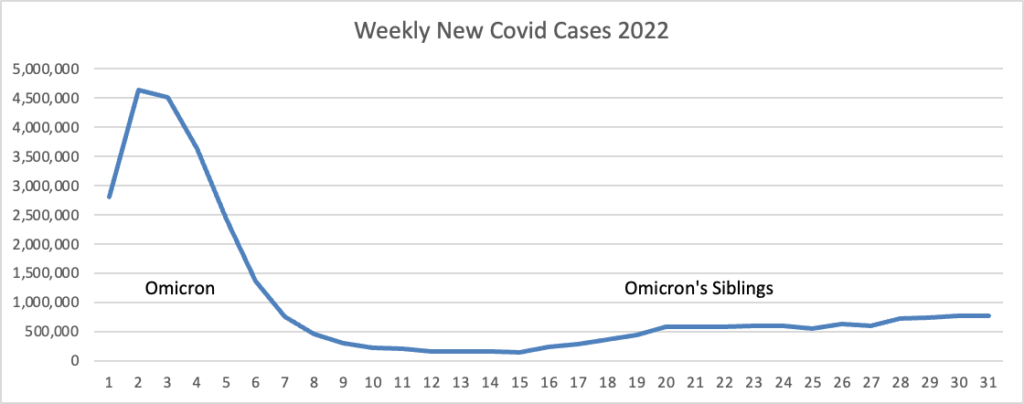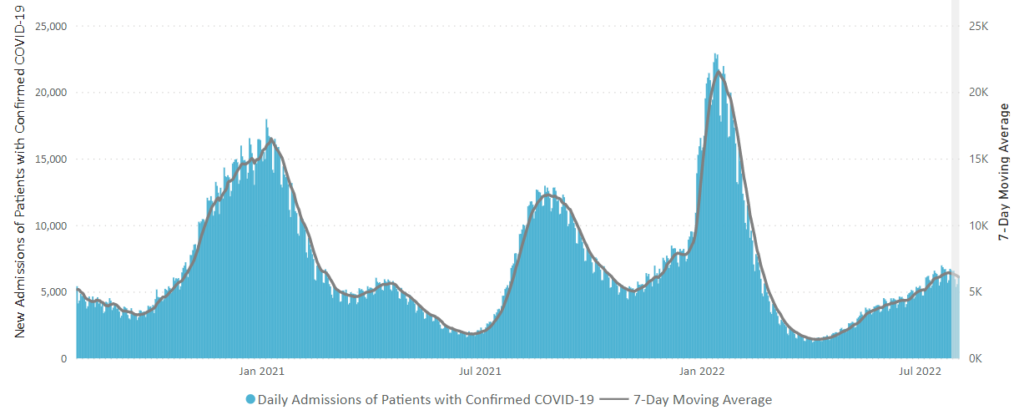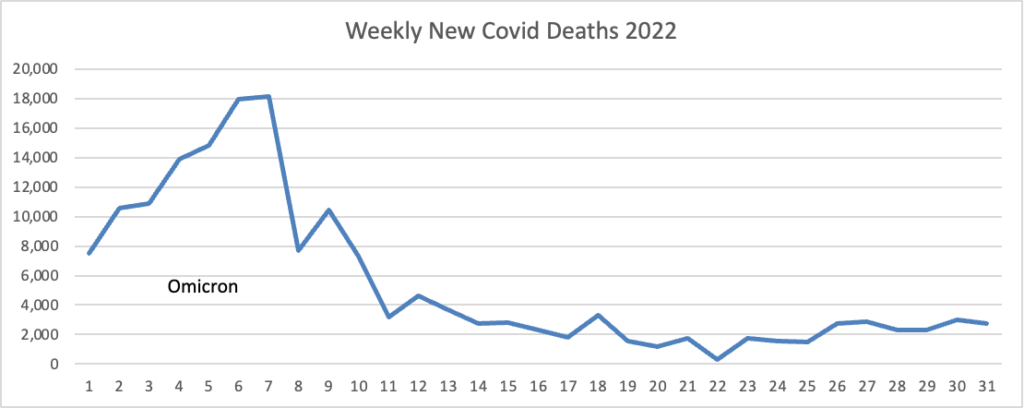Based on the CDC’s Covid Data Tracker and using Thursday as the first day of the week, here is the FEHBlog’s latest weekly chart of new Covid cases:

The CDC’s weekly review of its Covid statistics indicates
As of August 3, 2022, the current 7-day moving average of daily new cases (117,351) decreased 7.3% compared with the previous 7-day moving average (126,537).
CDC Nowcast projections* for the week ending July 30, 2022, estimate that the combined national proportion of lineages designated as Omicron will continue to be 100% with the predominant Omicron lineage being BA.5, projected at 85.5% (95% PI 83.8-87.0%).
Here’s the CDC’s chart of “Daily Trends in Number of New COVID-19 Hospital Admissions in the United States”:

The CDC’s weekly review notes “The current 7-day daily average for July 27–August 2, 2022, was 6,112. This is a 4.4% decrease from the prior 7-day average (6,396) from July 20–26, 2022.”
The Wall Street Journal observes
U.S. hospitalization data indicate the latest Covid-19 surge is starting to cool, marking a hopeful sign after months of sustained, high virus transmission due to BA.5 and other Omicron subvariants.
The seven-day average for people hospitalized with Covid-19 has recently flattened, while numbers of newly admitted patients have mostly trended lower since late July, federal data show. Though Covid-19 cases are loosely tracked now, as people test more at home, hospital data can reflect how much the virus is spreading in communities.
“We definitely have hit the plateau,” said Eric Topol, director of the Scripps Research Translational Institute in La Jolla, Calif.
The news is welcome, he said, as the U.S. nears the weeks in which most children will be crowding back into schools. Colleges are scaling back Covid-19 precautions for the fall as they prepare for an influx of students on campus.
Here’s the FEHBlog’s latest weekly chart of new Covid deaths:

The CDC’s weekly review states “The current 7-day moving average of new deaths (378) has decreased 4.9% compared with the previous 7-day moving average (397).” The Wall Street Journal adds
The U.S. has recently averaged 377 reported Covid-19 deaths a day, the CDC data show, far below all-time highs but above the low hit last summer. Known cases recently averaged about 117,000 a day, down slightly over the past week, though epidemiologists believe the true number of infections is significantly higher.
Here’s the FEHBlog’s weekly chart of Covid vaccinations distributed and administered from the beginning of the Covid vaccination era, the 51st week of 2020, through the 31st week of this year.

Covid vaccines administered dropped to around 500,000 last, a new low.
The Wall Street Journal reports
As of Thursday there were 1,344 counties—about 42% of the total—that have high Covid-19 community levels based on case and hospitalization trends, according to the Centers for Disease Control and Prevention. This is down 133 counties from the CDC’s count a week earlier.
About 55% of the U.S. population is now in a high-ranked county with elevated levels of disease, still significantly up from levels below 1% in March and April, but down from 61% a week earlier.
In sum, things are looking up from a Covid era perspective.
From the monkeypox front, the CDC released an information sheet on Monkeypox and Safer Sex.
From the patient safety front, Cardiovascular Business informs us
In 1999, the Institute of Medicine published a shocking report on medical errors that led to in-hospital deaths, noting that as many as 98,000 people per year were dying due to preventable errors.
Now, more than two decades later, are things any better? A team of researchers explored that very questions in JAMA, drawing mostly optimistic conclusions.[1]
To determine whether adverse in-hospital events are on the decline, Noel Eldridge, MS, of the U.S. Department of Health and Human Services, and coauthors looked at data from the Medicare Patient Safety Monitoring System from the years 2010 and 2019. The total number of adverse events dropped from 218 to 139 adverse events per 1,000 discharges for acute myocardial infarction (AMI), and from 168 to 116 adverse events per 1,000 discharges for heart failure, suggesting a significant improvement over time.
Congrats!
And for the Friday wrap up
Roll Call reports from Capitol Hill
The Senate is “on track” to start debating a roughly $300 billion deficit-reducing budget package Saturday after Democrats reached agreement late Thursday on changes to the bill needed to secure 50 votes, Senate Majority Leader Charles E. Schumer said.
The changes, the New York Democrat said at a news conference Friday, include dropping a provision modifying the taxation of “carried interest,” providing exemptions to the 15 percent corporate minimum tax that would reduce its estimated revenue raised over 10 years from $313 billion to $258 billion, and adding some climate provisions related to drought.
“We’re feeling pretty good,” Schumer said, noting he believes the agreement will have the votes to pass.
If so, the bill would then go to the House, which is expected to reconvene Aug. 12 to vote on it, according to a notice Friday from Majority Leader Steny H. Hoyer, D-Md.
Fierce Health summarizes the second quarter results of publicly traded health insurers.
A STATS News journalist provides three takeaways from the this year’s Alzheimer’s Association International Conference, which he attended.
